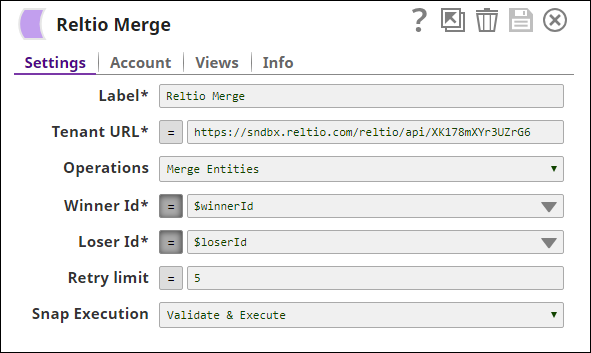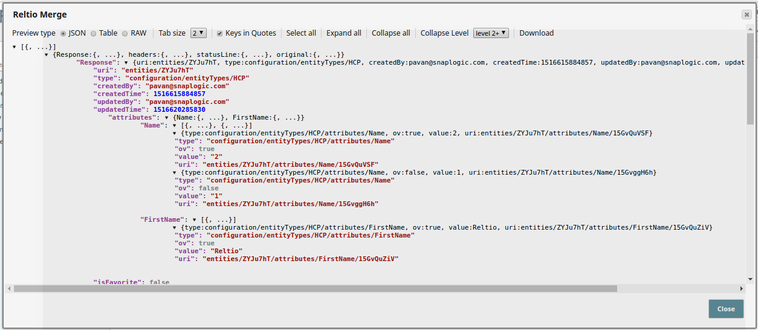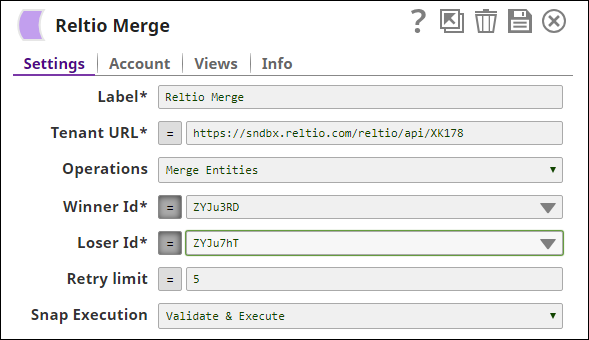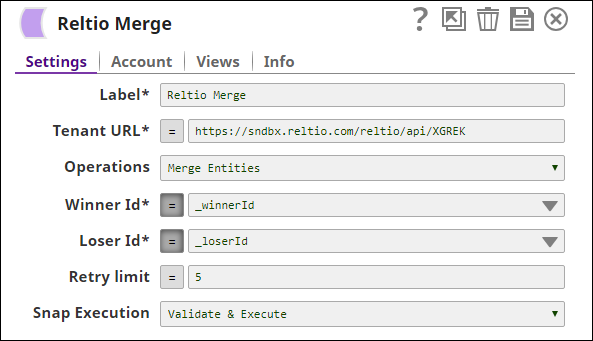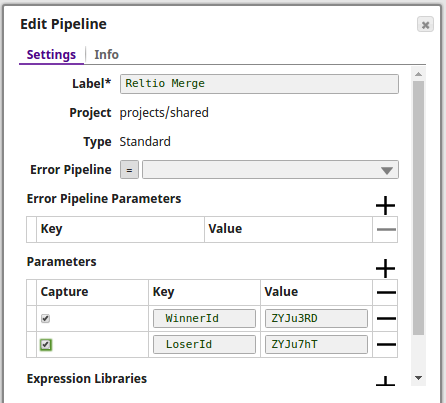Reltio Merge
On this Page
| Snap Type: | Transform | ||||||
|---|---|---|---|---|---|---|---|
| Description: | This Snap merges the Reltio Objects (Entities or Categories) data for a given Winner and Loser entity or for category IDs as mentioned on the Tenant. It provides a potential match between the two entities. Winner ID describes the Entity ID as a resulting 'survivor' and combines all attributes, crosswalks, roles and tags from the 'losing' entity into it. Loser ID describes the Entity ID to be merged into the Winner (survivor) object, where an entity corresponds to one of the Reltio Objects. ETL Transformations & Data FlowThe Snap transforms the existing entities provided as an input into a merged entity. Input & Output
Modes
| ||||||
| Prerequisites: | A valid Reltio account with the tenant ID for the Tenant URL, or an API key for the Account Settings to be generated. The Reltio account must have sufficient access to merge the objects or entities from the Tenant. | ||||||
| Limitations and Known Issues: | You cannot roll back the productized Reltio Snap Pack in 4.20 to a prior version. | ||||||
| Configurations: | Account & AccessThis Snap uses account references created on the Accounts page of SnapLogic Manager to handle access to this endpoint. See Reltio Account for information on setting up this type of account.
| ||||||
| Troubleshooting: | None at this time. | ||||||
Settings | |||||||
Label | Required. The name for the Snap. You can modify this to be more specific, especially if you have more than one of the same Snap in your pipeline. | ||||||
| Tenant URL | Required. This determines the Reltio host with tenant ID. Use this format: The value can be passed directly or through the pipeline parameters, but not through the upstream. Example: https://test.reltio.com/reltiotest/api/XKiqdracb178fmuXYr3U7ZrG6/ Default value: https://<your_reltio_host>/reltio/api/<tenant_id> | ||||||
| Operations | Specifies the merge operation to be performed. The available options are:
Default value: Merge Entities | ||||||
| Winner Id | Required. Specifies the Winner entity or category identifier. This field describes the entity ID as a resulting 'survivor' and combines all the attributes, crosswalks, roles and tags from the 'losing' entity into it. The value can be passed using the upstream Snap or through the pipeline parameters. Default value: $winnerId | ||||||
| Loser Id | Required. Specifies the loser entity or the category identifier. This field describes the Entity ID to be merged in the survivor object. The value can be passed using the upstream Snap or through the pipeline parameters. Default value: $loserId | ||||||
| Retry limit | Specify the maximum number of attempts to get the response. Minimum value: 1 Default Value: 5 You can provide this value dynamically as a Pipeline parameter or directly in the Snap, but not as an upstream value. | ||||||
Snap Execution | Select one of the following three modes in which the Snap executes:
Default Value: Execute only | ||||||
Basic Use Case
The following pipeline describes how the Snap functions as a standalone Snap in a pipeline:
Typical Snap Configurations
The key Snap configurations for the Snap are:
- With Expressions
The values are passes directly into the Snap:
- Without Expressions
- Using the Upstream Query: The values (Queue name and Queue URL) are passed using the upstream Snap:
- Using the Pipeline Parameters: The values (Winner Id and Loser Id) are passed using the pipeline parameters:
The values set as the pipeline parameters:
Advanced Use Case
The following describes a pipeline, with a broader business logic involving multiple ETL transformations, that shows how typically in an enterprise environment, the Reltio functionality is used. The pipeline download is available in the Downloads section.
This pipeline retrieves the data from the Oracle Database and loads into the Reltio instance.
The key ETL transformations:
Extract: The Oracle Select Snap retrieves the data from Oracle database.
Transform: The Head and the Mapper Snaps maps the specific data to be moved into the Reltio instance.
Load: The Reltio Create Snap creates the entities from the documents received from the upstream.
The pipeline further uses the Reltio Merge, Unmerge and the Delete Snaps to perform the respective functions while transforming ( the JSON Splitter, Mapper and the Head Snaps) the data to serve the various business purposes.
Downloads
Important steps to successfully reuse Pipelines
- Download and import the pipeline into the SnapLogic application.
- Configure Snap accounts as applicable.
- Provide pipeline parameters as applicable.
Snap Pack History
Have feedback? Email documentation@snaplogic.com | Ask a question in the SnapLogic Community
© 2017-2025 SnapLogic, Inc.

